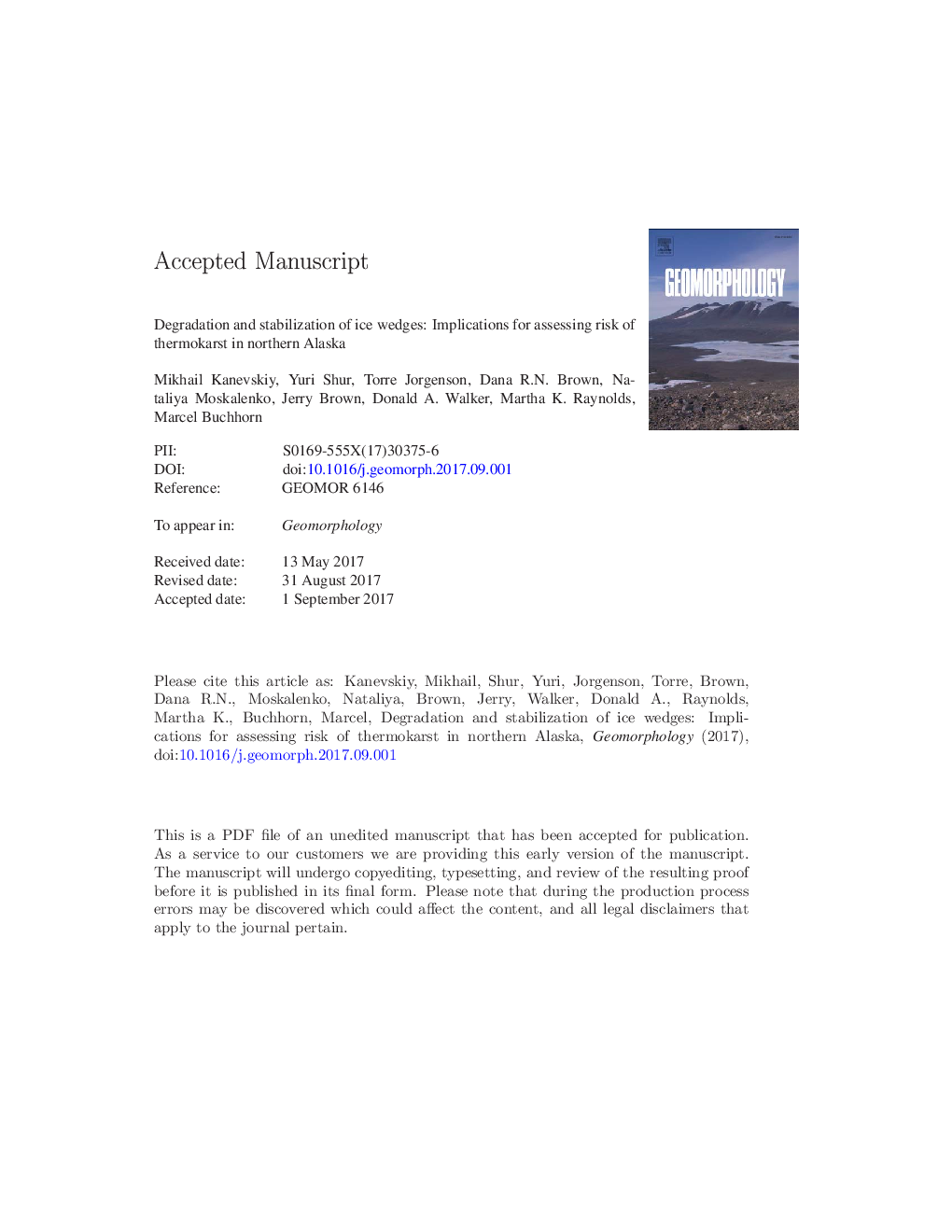| کد مقاله | کد نشریه | سال انتشار | مقاله انگلیسی | نسخه تمام متن |
|---|---|---|---|---|
| 5780862 | 1635353 | 2017 | 78 صفحه PDF | دانلود رایگان |
عنوان انگلیسی مقاله ISI
Degradation and stabilization of ice wedges: Implications for assessing risk of thermokarst in northern Alaska
ترجمه فارسی عنوان
تخریب و تثبیت قله یخ: اثرات ارزیابی خطر ترموکارد در شمال آلاسکا
دانلود مقاله + سفارش ترجمه
دانلود مقاله ISI انگلیسی
رایگان برای ایرانیان
کلمات کلیدی
طول عمر فروتن، یخ زمینی، خاک های یخ زده، لایه متوسط،
موضوعات مرتبط
مهندسی و علوم پایه
علوم زمین و سیارات
فرآیندهای سطح زمین
چکیده انگلیسی
Widespread degradation of ice wedges has been observed during the last decades in numerous areas within the continuous permafrost zone of Eurasia and North America. To study ice-wedge degradation, we performed field investigations at Prudhoe Bay and Barrow in northern Alaska during 2011-2016. In each study area, a 250-m transect was established with plots representing different stages of ice-wedge degradation/stabilization. Field work included surveying ground- and water-surface elevations, thaw-depth measurements, permafrost coring, vegetation sampling, and ground-based LiDAR scanning. We described cryostratigraphy of frozen soils and stable isotope composition, analyzed environmental characteristics associated with ice-wedge degradation and stabilization, evaluated the vulnerability and resilience of ice wedges to climate change and disturbances, and developed new conceptual models of ice-wedge dynamics that identify the main factors affecting ice-wedge degradation and stabilization and the main stages of this quasi-cyclic process. We found significant differences in the patterns of ice-wedge degradation and stabilization between the two areas, and the patterns were more complex than those previously described because of the interactions of changing topography, water redistribution, and vegetation/soil responses that can interrupt or reinforce degradation. Degradation of ice wedges is usually triggered by an increase in the active-layer thickness during exceptionally warm and wet summers or as a result of flooding or disturbance. Vulnerability of ice wedges to thermokarst is controlled by the thickness of the intermediate layer of the upper permafrost, which overlies ice wedges and protects them from thawing. In the continuous permafrost zone, degradation of ice wedges rarely leads to their complete melting; and in most cases wedges eventually stabilize and can then resume growing, indicating a somewhat cyclic and reversible process. Stabilization of ice wedges after their partial degradation makes them better protected than before degradation because the intermediate layer is usually 2 to 3 times thicker on top of stabilized ice wedges than on top of initial ice wedges in undisturbed conditions. As a result, the likelihood of formation of large thaw lakes in the continuous permafrost zone triggered by ice-wedge degradation alone is very low.
ناشر
Database: Elsevier - ScienceDirect (ساینس دایرکت)
Journal: Geomorphology - Volume 297, 15 November 2017, Pages 20-42
Journal: Geomorphology - Volume 297, 15 November 2017, Pages 20-42
نویسندگان
Mikhail Kanevskiy, Yuri Shur, Torre Jorgenson, Dana R.N. Brown, Nataliya Moskalenko, Jerry Brown, Donald A. Walker, Martha K. Raynolds, Marcel Buchhorn,
